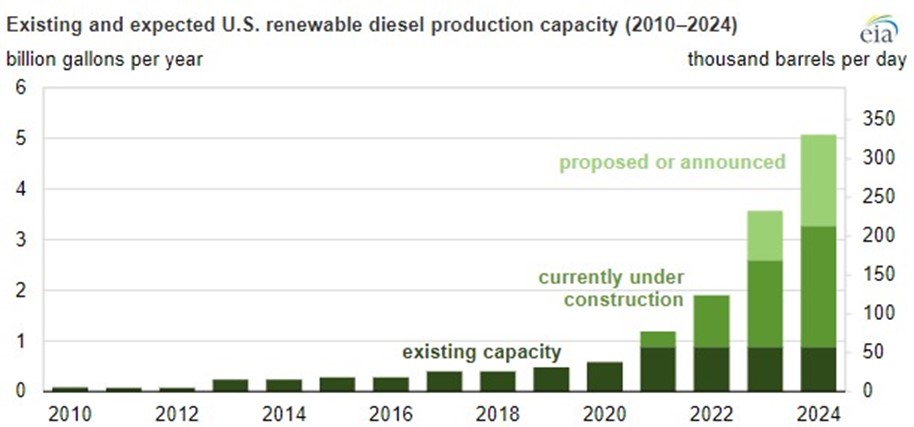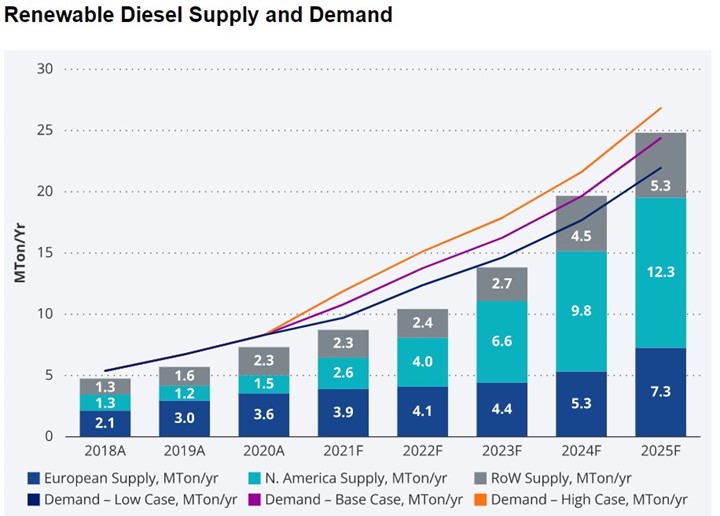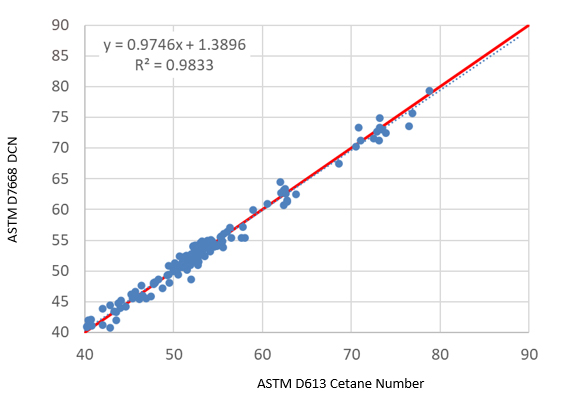- Zero emissions of nitrogen oxide (NOx) – which can cause acid rain and smog
- Higher cetane number (>70) – meaning it burns cleaner than biodiesel
- Delivers more power to the engine than biodiesel
- Does not require equipment upgrades prior to use
- Can be fully substituted for petroleum diesel without any dilutions or blending
- Allows for improved fuel stability
- Improved cloud-point and cold-flow properties
Future forecast
The renewable diesel market supply is expected to grow from approximately 5 million tons per year (MTon/yr) in 2018 to approximately 25 MTon/yr by 2025 and 30 MTon/yr by 2030.
U.S. production capacity for renewable diesel could increase significantly through 2024. As of the end of 2020, U.S. renewable diesel production capacity totaled 0.6 billion gallons annually. Several projects currently under construction could increase this capacity by 2.4 billion gallons and proposed and announced projects would add another 1.8 billion gallons annually by 2024.

Source: U.S. Energy Information Administration (EIA), based on data from company announcements in trade press.
Europe is currently responsible for approximately 50% of total global renewable diesel supply, but is anticipated to transition from an exporter to an importer of renewable diesel over the next 5 years due to increasing demand.

Source: Seeking Alpha, Barclays (demand bottom-up base case model), VanEck (supply bottom-up model), BNEF and company and country data.
Challenges
The primary challenge to higher utility of renewable diesel is the cost of production. It’s not currently cost-competitive with petroleum diesel. Nevertheless, as more nations strive for sustainability ambitions and shift to green fuels, renewable diesel offers a higher quality end product and provides greater power and efficiency than biodiesel. Also because renewable diesel doesn’t require equipment modifications, many projections suggest that renewable diesel will become the preferred option when considering biomass-based diesel.
PAC Solutions for Renewable Diesels
Parameter
|
Conventional Diesel D975 , EN 590
|
Paraffinic HVO EN 15940
|
PAC Solution
|
| Cetane |
≥ 40 (D975) /
≥ 51 (EN 590) |
≥ 70
|
D7668: CID 510
|
| Cloud point / Pour point |
|
|
D5771, D5950: OptiCPP,
D5773, D5949: DFA-70Xi
D7689: D7346: OptiMPP
|
| Viscosity |
|
|
D445: HVM
D7945: DFA-70Xi, OptiMVD
|
| Flash point |
≥ 52°C (D975) /
≥ 55°C (EN 590) |
≥ 55°C |
D93 / IP 34: OptiFlash PM
D3828 / IP 523: OptiFlash small scale
D56 / IP 170: OptiFlash Tag & Abel
|
| Sulfur |
≤ 15 ppm |
≤ 15 ppm |
D5453: ElemeNtS
|
| Distillation |
|
|
D86 / IP 123: OptiDist
D2887 / IP 406: Sim Dist
D7345 : OptiPMD
|
| Thermal Oxidative Stability |
|
Non-mandatory |
DTOT: special research tool for Diesels based on D3241
|
Since HVO possesses superior cetane value, It is often used as a blendstock for petroleum diesel to improve and bring the product to specification. The CID 510 measures DCN (Derived Cetane Number), which is a fast and accurate correlation of the cetane number for both the neat HVO and the blended final product.

The CID 510 has been extended to correlate to cetane number (ASTM D613) from 39 to 80, covering the range for conventional diesel, biodiesel, renewable diesel and HVO.
Likewise, HVO can be processed with Improved cold properties over FAME, and therefore are used as blendstock to optimize the cold flow specification. All of OptiCPP, OptiMPP, and DFA-70Xi provide fast measurements for both cloud and pour points. The DFA-70Xi also combines cloud/pour, viscosity, and density measurement in a single analyzer.
Detects Total Sulfur and/or Total Nitrogen efficiently using ultraviolet fluorescence (UVF) and chemiluminescence (CLD) in solid, liquid, gaseous materials and LPG samples, including HVO and renewable diesel blends.
Measure the distillation characteristics of renewable diesel using either automated D86 methodology or with reduced sample volume and fast speed with D7345.
Summary
Renewable diesel has become a leading solution to replace petroleum-based diesel as the world transition from first-generation biodiesel for the heavy-duty transport sector.
PAC has decades of experience in helping the diesel fuel industry to comply with many standards. We have instruments for a wide range of parameters, including cetane, cloud and pour points, viscosity, flash point, sulfur, distillation, and more. Beyond our product capabilities lies our depth of application knowledge and a deep understanding of specifications as ASTM D975, EN 590, EN 15940, and many other national specifications.
See PAC’s complete portfolio of solutions for diesel: https://www.paclp.com/lab-instruments/application/diesel
Download our brochure on Renewable Diesel
Please contact PAC for more information and detailed discussion
